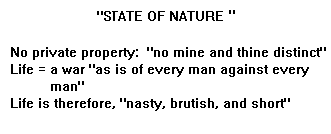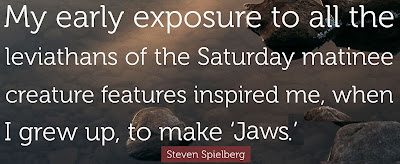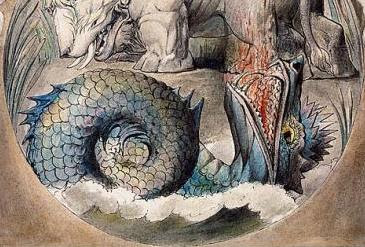It rises from the deep
Opening its eyes
After twenty centuries of stony sleep...
"When the truth gets buried deep
Beneath the thousand years asleep
Time demands a turnaround
And once again the truth is found"
hurdy gurdy kraki-boo
that twisted serpent of old they call the Leviathan
by the picking of the name, something crooked this way came...
'There is no power on earth to be compared to HIM'
"His heart is as firm as a stone..." Job 41:24
The most popular of texts to bear the title Leviathan, by the most famous of persons named Hobbes
...an "artificial person" and as a body politic that mimics the human body
Sea monster? Why yes, I do.
There are two types of persons, natural and artificial. A "natural
person" is one whose words are his or her own. An "artificial person" is
one whose words are those of someone else. Thus, a natural person is
analogous to an "author," who is the originator of words. All the
natural men in the state of nature are natural persons; their words are
their own when they make a contract to escape the state of nature, and
so they are authors of the contract. The contract becomes a
representative of the natural people, encompassing and joining their
identities; the multitude of natural persons, all authors, condense
their wills into the single representation and, in so doing, the
multitude becomes unified. Because the contract is a representative, or
an actor, impersonating the words of natural persons, it fits the
definition of an artificial person. The contract, symbolizing social
unity, is an artificial person, and with this equation Hobbes launches
the powerful iconography of the Leviathan.
the gaze of the multitude is fastened exclusively upon their Prince, while he himself, ignoring them, fixes his gaze upon some audience beyond them, an audience not revealed to the viewer
Hobbes's philosophical method in Leviathan is modeled after a geometric proof, founded upon first principles and established definitions, and in which each step of argument makes conclusions based upon the previous step. Hobbes decided to create a philosophical method similar to the geometric proof after meeting Galileo on his extended travels in Europe during the 1630s. Observing that the conclusions derived by geometry are indisputable because each of the constituent steps is indisputable in itself. Hobbes attempted to work out a similarly irrefutable philosophy in his writing Leviathan.
(by an hook or) by A. Crooke
"By hook or by crook" is an English phrase meaning "by any means necessary", suggesting that any means possible should be taken to accomplish a goal. The phrase is very old, first recorded in the Middle English Controversial Tracts of John Wyclif in 1380.
The origin of the phrase is obscure, with multiple different explanations and no evidence to support any particular one over the others. For example, a commonly repeated suggestion is that it comes from Hook Head in Wexford, Ireland and the nearby village of Crooke, in Waterford, Ireland. As such, the phrase would derive from a vow by Oliver Cromwell to take Waterford by Hook (on the Wexford side of Waterford Estuary) or by Crook (a village on the Waterford side); although the Wyclif tract was published at least 260 years before Cromwell. Another is that it comes from the customs regulating which firewood local people could take from common land; they were allowed to take any branches that they could reach with a billhook or a shepherd's crook (used to hook sheep).
The phrase was featured in the opening credits to the 1960s British television series The Prisoner. It appears prominently (as "by hook and by crook") in the short stories "The Snows of Kilimanjaro" by Ernest Hemingway and "The Legend of Sleepy Hollow" by Washington Irving.
In Modern English, the meaning of the phrase is often misunderstood as to refer more specifically to a willingness to accomplish objectives using unethical and/or illegal (as in "crooked") means, or having patience as with a fishing hook, or by using force as done in a robbery by a 'crook'. The phrase has become increasingly common for the outcome of boxing matches - with a 'hook' being a victory by KO or stoppage, and 'crook' being a victory by way of judges, given the sometimes controversial outcome decisions in matches.






One is hard pressed to find a few words go by in Revelation without some
kind of allusion to a Bible passage. John, the author, is pulling
references from left and right. With this in mind, it's not unthinkable
to see the Leviathan of the Old Testament resurface, especially given
the fact that Isaiah said God would deal with Leviathan in the end-times
(Isaiah 27:1). And sure enough, we see him boldly and chaotically enter
into the story.
This seven-headed dragon seems an obvious callback to many-headed Leviathan (Psalms 74:14), though this time he is identified as "the ancient serpent, who is called the devil and Satan, the deceiver of the whole world" (Revelation 12:9) He and his monster entourage have come to Earth and are wreaking chaos upon it. They are opposite of God and therefore, the opposite order. They want the violent and moral ruin of humanity. The creature that Isaiah prophesied God would slay now shows his many faces in Revelation 12, and no one can miss it.
Of course, Satan isn't the only seven-headed creature in Revelation; for one of Satan's minions, the fire beast, rises "up out of the sea, having seven heads and ten horns, and upon his horns ten crowns, and upon his heads the name of blasphemy." (Revelation 13:1). In fact,







































































































































































































































